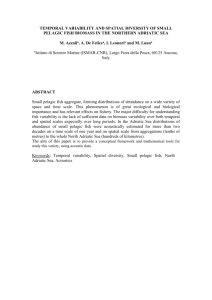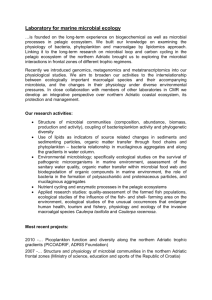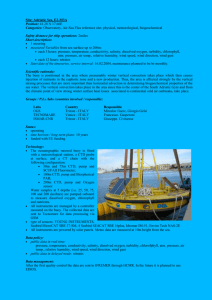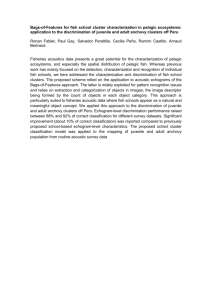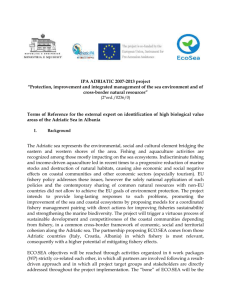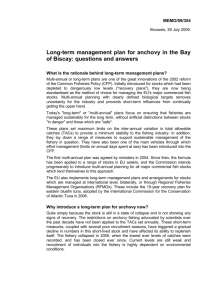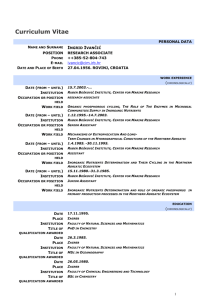gsa17-VPA-anchovy1975-2004-sac2005-paper
advertisement
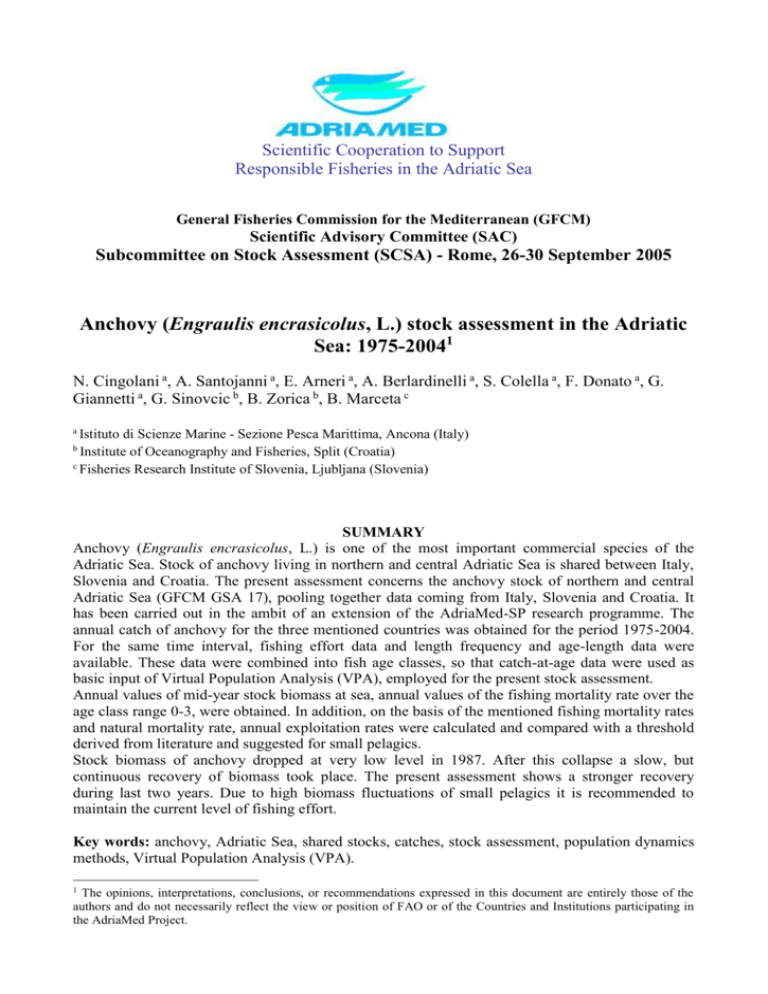
Scientific Cooperation to Support Responsible Fisheries in the Adriatic Sea General Fisheries Commission for the Mediterranean (GFCM) Scientific Advisory Committee (SAC) Subcommittee on Stock Assessment (SCSA) - Rome, 26-30 September 2005 Anchovy (Engraulis encrasicolus, L.) stock assessment in the Adriatic Sea: 1975-20041 N. Cingolani a, A. Santojanni a, E. Arneri a, A. Berlardinelli a, S. Colella a, F. Donato a, G. Giannetti a, G. Sinovcic b, B. Zorica b, B. Marceta c a Istituto di Scienze Marine - Sezione Pesca Marittima, Ancona (Italy) Institute of Oceanography and Fisheries, Split (Croatia) c Fisheries Research Institute of Slovenia, Ljubljana (Slovenia) b SUMMARY Anchovy (Engraulis encrasicolus, L.) is one of the most important commercial species of the Adriatic Sea. Stock of anchovy living in northern and central Adriatic Sea is shared between Italy, Slovenia and Croatia. The present assessment concerns the anchovy stock of northern and central Adriatic Sea (GFCM GSA 17), pooling together data coming from Italy, Slovenia and Croatia. It has been carried out in the ambit of an extension of the AdriaMed-SP research programme. The annual catch of anchovy for the three mentioned countries was obtained for the period 1975-2004. For the same time interval, fishing effort data and length frequency and age-length data were available. These data were combined into fish age classes, so that catch-at-age data were used as basic input of Virtual Population Analysis (VPA), employed for the present stock assessment. Annual values of mid-year stock biomass at sea, annual values of the fishing mortality rate over the age class range 0-3, were obtained. In addition, on the basis of the mentioned fishing mortality rates and natural mortality rate, annual exploitation rates were calculated and compared with a threshold derived from literature and suggested for small pelagics. Stock biomass of anchovy dropped at very low level in 1987. After this collapse a slow, but continuous recovery of biomass took place. The present assessment shows a stronger recovery during last two years. Due to high biomass fluctuations of small pelagics it is recommended to maintain the current level of fishing effort. Key words: anchovy, Adriatic Sea, shared stocks, catches, stock assessment, population dynamics methods, Virtual Population Analysis (VPA). 1 The opinions, interpretations, conclusions, or recommendations expressed in this document are entirely those of the authors and do not necessarily reflect the view or position of FAO or of the Countries and Institutions participating in the AdriaMed Project. 1. Background The small pelagic species (Anchovy - Engraulis encrasicolus, L. and Sardine - Sardina pilchardus, Walb.) are of key importance for Adriatic fisheries2. They represent about 80% of the Italian small pelagic catches, and a considerable percentage of the Croatian total catches and of the catches Slovenian catches. The small pelagic fishery has developed on both sides of the Adriatic; however, more than 90% of the anchovy catches are landed by the Italian fleet3 (Fig. 1), while the pelagic fleets from the Slovenia and Croatia have concentrated primarily on sardines. Since the seventies the eastern Adriatic sardines catches were comparable with the Italian Adriatic catches (Anonymous, 1975 - 1993; Anonymous, 1994), while in the last years Croatian sardine catches are higher than Italian ones. See Figure 2. Anchovy: catch 60000 Catch (tonnes) 50000 40000 30000 20000 10000 0 75 77 79 81 83 85 87 89 91 93 95 97 99 01 03 Year main ports small ports east-Adriatic Fig. 1 - Adriatic (northern and central) anchovy landed catches Sardine: catch 90000 Catch (tonnes) 75000 60000 45000 30000 15000 0 75 77 79 81 83 85 87 89 91 93 95 97 99 01 03 Year main ports small ports east-Adriatic Fig. 2 - Adriatic (northern and central) sardine landed catches 2 Because small pelagic fisheries concern anchovy and sardine, background description is the same for the two papers of the two species, presented at the 2005 Sub-Committee on Stock Assessment (SAC-SCSA). 3 In 2004 Croatian anchovy catches increased till to 23% of anchovy catches. D:\106752414.doc 2 Anchovy and sardine are the most important species of the shared small pelagics stocks: in Italy and Croatia, sprat and sardinella are almost completely absent from the landed catches, and mackerel represents about 4 - 5% of the catches in the total of anchovies and sardines. In Slovenia the sardine catches represent more than 90% of the national catches (Marceta, 2001). Sprats are fished in the North Adriatic, while the fishing area of sardinella is in the South. In Italy, in terms of market price, anchovies are considerably more valuable than sardines. Due to catches decrease, in the last years the price of sardine has risen. In some ports and in some periods market price of sardine is higher than anchovy. In Slovenia and Croatia, sardines are more desirable than anchovies (Marceta, 2001; Sinovcic, 2001). Italian northern and central Adriatic catches of sardines reached a maximum value, (59,000 tonnes), in 1981, decreasing in successive years; current catches are about 4,000 tonnes. Slovenian sardines catches were 6,600 tonnes in 1983, while the present catches are around 300 tonnes. Croatian sardine catches reached a maximum in 1983 (40,044 tonnes) and in 1987 (38,439 tonnes). Significant decreases in catches were noted after 1990. Present Croatian catches are about 16,000 tonnes. Present Adriatic sardine catches (GSA 17) are about 20,000 tonnes. A high percentage of sardine catches is directed to the fish processing industry. Anchovy catches in Italy reached a maximum value in 1980 (57,328 tonnes) followed by a quick decay in successive years until the crash of the 1987 (3,375 tonnes). Anchovy catches in Croatia reached a maximum value in 1985 (3,245 tonnes), followed by a period of decreases till 1998. After this year, anchovy Croatian increased reaching a new maximum value in 2004 (7,473 tonnes). In the last years, Adriatic anchovy population showed a recovery, nevertheless biomass seems to fluctuate again. Present catches of anchovies in the Adriatic (GSA 17) are about 33,000 tonnes. Two types of fishing gear are used in Adriatic: midwater pelagic pair trawls (volante) and purse seines with light attraction (lampara). The Italian pelagic fleet is distributed along the Adriatic coastline from Trieste to Vieste (GSA 17) and Croatian from Umag to Dubrovnik. Italian fleet is composed of about 102 (51 pairs) volanti vessels mainly operating from Trieste to Ancona and of about 42 lampara vessels operating in the Gulf of Trieste (small lampara) and in the Central Adriatic Sea (big lampara). Most small pelagics are caught in the Northern and Central Adriatic: in the western part from Trieste to Vieste, whereas in the eastern part, they are mainly caught from the Istria to the MidDalmatian islands. The small pelagic fishery is very important in the Adriatic fishery (in particular, anchovy and sardine) for economic reasons (total value of catches) and for social reasons (number of fishermen involved). Fish market preferences (anchovies are appreciated on the western coast, while sardines are appreciated on the eastern coast) should help a joint management of small pelagic fisheries. It could avoid also discarding at sea of sardines, a common practice in Italy due to a constant low price of sardines. Fortunately, this practice in the last years was negligible because the price of sardines has risen. The Adriatic area can be best understood when viewed in two Geographical Management Units, MU, currently referred to as Geographical Sub-Areas (GSA; GFCM, 2001). The MU 37.2.1.a (currently GSA 17) encompasses the North and Central Adriatic and its Southern boundary is the straight line between the mouth of the stream Saccione (Northern limit of the Italian Manfredonia fishery district) and the Croatia-Montenegro border (Cape Ostro on Prevlaka Peninsula. The map in Figure 3 shows the AdriaMed proposed modification of boundaries of Adriatic Geographical Management Unit 37.2.1.a (GSA 17) and 37.2.2.b (GSA 18; from the solid line to dotted line). The new boundaries are well suited to the physical differences between the North Adriatic, Central Adriatic, South Adriatic, and the present boundaries of Adriatic countries (AdriaMed, 2001). D:\106752414.doc 3 Fig. 3 - Map showing the boundaries of the Adriatic Sea Geographical Sub-Areas (formerly Geographical Management Units) as originally indicated by the GFCM (solid line) and with the recent revision (dotted line) 2. Methodological notes Commercial catch data collection on a regional scale in Italy, Slovenia and Croatia has been carried out by port sampling network established through AdriaMed as described in Cingolani and Santojanni (2003). The data collection system adopted is coherent with that established in Italy by ISMAR (formerly IRPEM) since 1975 (Cingolani et al., 2001). The anchovy stock assessment for the time period 1975-2004 was carried out by means of Virtual Population Analysis (VPA), which is a population dynamics method based on analysis of the age frequency distributions of total catches (Hilborn and Walters, 1992). Assessments based on VPA for the same stock (as well as for the sardine stock) and using the same core of data collection, were also carried in the past (Cingolani et al., 1996, 2000, 2001; Santojanni et al., 2001; Cingolani et al., 2002; Santojanni et al., 2003; Cingolani et al., 2004a,b; Santojanni et al., 2005; Santojanni et al., in press). Since the reproduction of the Adriatic anchovy is particularly relevant in spring-summer and a conventional birthday on the first of June is more coherent with the biology of the species, assessment was carried out taking into account a birthday date. The birthday effect is expected to be not negligible more likely in the assessments based on catch at age data, just like VPA. Consequently, all data originally recorded according to calendar year were modified in order to calculate split year ones, using the first day of June as the birthday, so that data relative to one year x were referred to the time interval ranging from the first of June of the year before up to the 31st day of May of that year x (Santojanni et al., 2003). Hence, on split year basis, the time series analyzed was since 1976 up to 2004. Age of fish was estimated by reading otoliths. Age-length keys were applied to the annual catch D:\106752414.doc 4 weighted length frequency distributions of the catch in order to obtain corresponding age distributions, with the age classes ranging from 0 to the plusgroup 4+ (i.e. including individuals older than 4 years). VPA was carried out using the Laurec-Shepherd tuning (Laurec and Shepherd, 1983; Pope and Shepherd, 1985). The Laurec-Shepherd tuning attempts to estimate the fishing mortality rate at age in the most recent year, Fage, year (yr-1), by fitting to CPUE-at-age data in earlier years, under the assumption that the annual catchability at age, qa , is constant over time. At this aim, the appropriate tuning time interval, in which catchability is thought to have been relatively constant, was selected (see Results). The first, and more commonly used method (Method 1 in the text), makes the additional assumption that the annual F at the oldest age is equal to the product between the constant k (fixed) and the average of the values of F obtained for a fixed number, n, of younger ages in the same year. The second method (Method 2) requires the user to specify a vector of annual Fs (i.e. fixed) at the oldest age (Darby and Flatman, 1994; Santojanni et al., 2003). In the present work, both methods were employed and tuning was carried out with respect to standardized Porto Garibaldi CPUE-at-age data. The fishing effort used to obtain the mentioned CPUE was thought as directed to both anchovy and sardine, and annual (as well as monthly) values were calculated for the fleet of the Italian port of Porto Garibaldi, whose anchovy and sardine catches over the period 1976-2004 are around 20% (25% in some years) of the total, respectively. Effort was standardized (Santojanni et al., 2002) by using Generalized Linear Model (GLM) as suggested by Hilborn and Walters (1992). Combining this effort with corresponding catches, CPUEs were obtained for the same fleet. In particular, the catches were distributed into the age classes so that CPUE-at-age data were obtained. In VPA calculations, the annual natural mortality rate, M, is assumed constant over ages and years. The value M = 0.6 yr-1 was used: it was selected on the basis of both the age composition of catches and estimates reported in literature (Santojanni et al., in press). The longevity suggested for anchovy by our age-length keys is lower than for sardine, for which we used M = 0.5 (see the corresponding working paper). The oldest individuals are in fact in the age class 6. Anyway, the value M = 0.6 is near the lowest end limit of the interval of values reported in literature and, here, was taken also according to a precautionary approach. Therefore, VPA was also performed using M = 0.8 and some results are reported below. The criterion to select M on the basis of an inverse relationship with longevity is adopted for small pelagics by other authors; as reported in a recent GLOBEC report (Barange, 2001), Pacific sardine (Sardinops sagax) is usually assumed to have a relatively low annual natural mortality rate, M = 0.4, and a lifespan of about 10 years, whereas for northern anchovy (Engraulis mordax) M = 0.8 is associated to a lifespan of about 4 years. Finally, a reference to the well studied case of Catalan Sea is worth: for the anchovy stock, Pertierra and Lleonart (1996) mentioned M = 0.54 and M = 0.81, which are very similar to the values employed here for Adriatic anchovy. Finally, VPA was performed using the version 3.2 of the software package MAFF-VPA (Ministry of Agriculture, Fishery and Food, UK), developed by Darby and Flatman (1994). 3. Results The selected tuning time interval has been made 1976-2004, using higher weights for the period 2001-2004. This choice was made on the basis of appropriate diagnostics, with log catchability at age being plotted over time (not reported here). In the previous assessment presented in the SAC D:\106752414.doc 5 meeting of 2004, the choice was very similar, the tuning time interval being 1976-2003 and weights on 1997-2003. Total annual catches and mid-year total stock biomass are compared over time in Fig. 4 (left graphic). Three series of estimated biomass are shown: they were obtained by using Method 1, with k = 1.6 and n = 1 or 2 or 3. In the right graphic of the same picture, the pattern of the fishing mortality rate as a function of age is shown for each of the three series reported in the left graphic; the values of F plotted are the averages calculated on the whole period 1976-2004. All these series show estimates in recent years similar to those obtained in 1986-1988: this does not sound sensible as, in that period, a stock collapse occurred along with crisis of anchovy fishery. In particular, the estimated ratio between the average biomass in the two periods 1986-1988 and 19992001 increases with n: it is 0.97, 1.11, 1.60, for n = 1, n = 2, n = 3, respectively. The results obtained using values of k lower than 1.6 have not been reported just because of the high values of the mentioned ratio. 350000 Midy biomass (k=1.6, n=2) Midy biomass (k=1.6, n=3) Tonnes 250000 200000 150000 100000 50000 0.90 0.80 Fishing mortality rate Catches Midy biomass (k=1.6, n=1) 300000 0.70 0.60 k=1.6 and n=1 0.50 k=1.6 and n=2 0.40 k=1.6 and n=3 0.30 0.20 0.10 0.00 0 76 78 80 82 84 86 88 90 92 94 96 98 00 02 04 0 Year 1 2 Age class 3 Fig. 4 (see text above) Anyway, all the assessments relative to Fig. 4 do not seem enough reliable, because of a too sharp increase of F at the oldest age or too low values of biomass after the end of 1990s (even lower than in the period of real collapse of anchovy stock). Thus, the VPA run was repeated by means of Method 2, using a vector of fixed values of F at oldest age, i.e. 3 and 4+ in the present case. These were obtained by using the following proportion between F3, year x and Porto Garibaldi standardized fishing effort, Eyear x , as follows: F3, year x / Eyear x = F3, 1976 / E1976 where F3, year x was assumed to be equal to the corresponding value obtained from VPA by using Method 1 with k = 1.6 and n = 2. In the Table 1, some values estimated by the three runs with Method 1 for 1976 and immediately subsequent years are reported. The value 0.27, corresponding to the assessment selected (n = 2), is intermediate between 0.47 (n = 1) and 0.12 (n = 3), thus very close to the average of the three values (0.29). The values of F3, 1976 obtained for the period 19771979 are higher, because of the higher values of corresponding fishing effort: an other scenario could be represented by a value of F3, 1976 equal to the mean calculated using 0.27 and the values of some subsequent years (e.g. 0.34 and 0.49, for n = 2): this mean is higher than 0.27; in other words, the values selected here for F at the oldest age, starting from 0.27, do not represent the most conservative scenario (the higher the fishing mortality the lower the biomass at sea). Finally, as verified by the numerous runs of VPA and the same nature of VPA algorithms, the values in the Table 1 were not influenced by the tuning time interval selected and the different weights on the years within this interval. D:\106752414.doc 6 Table 1 year 1976 1977 1978 1979 F oldest age (k=1.6, n=1) 0.47 0.57 0.79 0.73 F oldest age (k=1.6, n=2) 0.27 0.34 0.49 0.53 F oldest age (k=1.6, n=3) 0.12 0.16 0.25 0.30 The complete series of F for the age class 3 (= 4+) is shown in Fig. 5. The trend of this series is necessarily the same of Porto Garibaldi fishing effort. 0.70 Fishing mortality rate for age 3 and 4+ 0.60 0.50 0.40 0.30 0.20 0.10 0.00 76 78 80 82 84 86 88 90 92 94 96 98 00 02 04 Year Fig. 5 (see text above) The total annual catches and mid-year total stock biomass obtained by means of VPA with Method 2 are compared over years in Fig. 6. In the same picture, these biomass values are compared with those calculated as a mean of two trends presented in the previous SAC meeting of 2004, with data updated to 2003, and one trend presented in the SAC meeting of 2003, with data updated to 2002. The mean value of biomass estimated in the present assessment is equal to 114,000 tonnes; this means is higher when it is calculated in the last three years: 127,000 tonnes. The average catch is around to 25,000 tonnes in the period 1976-2004 and 23,000 in the last three years. Under the less conservative scenario due to the use of M = 0.8, the mean biomass values become 156,000 and 179,000 tonnes for the whole period and last three years, respectively. 300000 250000 Catches Midy biomass (SAC 2005) Midy biomass (mean SAC 2003-2004) Tonnes 200000 150000 100000 50000 0 76 77 78 79 80 81 82 83 84 85 86 87 88 89 90 91 92 93 94 95 96 97 98 99 00 01 02 03 04 Year Fig. 6 (see text above) D:\106752414.doc 7 A comparison between the biomass trend of VPA and the trend of average density (t/nm 2) of anchovy coming from acoustic survey (Cingolani et al., 2004b; Azzali et al., 2002) presented at GFCM-SAC Working Group on Small Pelagics (Malaga, 6-7 May 2004), showed a quite similar trend for the period 1987-2001. The pattern of the fishing mortality rate as a function of age, relative to the present assessment (see Fig. 6 above), is shown in Fig. 7, where it is compared with that relative to the Method 1 with k = 1.6 and n = 2 (see Fig. 4 above). The values of F plotted are the averages calculated on the whole period 1976-2004. Method 2 provides a pattern of fishing mortality rate at age with a less sharp increase of the case of Method 1. The former pattern seems more realistic. 0.90 Fishing mortality rate 0.80 0.70 0.60 k=1.6 and n=2 0.50 0.40 fixed F oldest age 0.30 0.20 0.10 0.00 0 1 2 3 Age class Fig. 7 (see text above) The mean of unweighted F for the age class range 0-3 is plotted over years in Fig. 8. The series shown is that obtained by means of Method 2. On the whole period 1976-2004, the average of F0-3 is equal to 0.29; the same average calculated in the last three years is slightly lower: 0.24. 0.90 Fishing mortality rate 0.80 0.70 0.60 0.50 0.40 0.30 0.20 0.10 0.00 76 78 80 82 84 86 88 90 92 Year 94 96 98 00 02 04 Fig. 8 (see text above) The ratio between total annual catches and start of year total stock biomass obtained using Method D:\106752414.doc 8 2 are plotted over years in Fig. 9. On the whole period 1976-2004, the average ratio is equal to 0.15; the same average calculated in the last three years is slightly lower: 0.12. It should be remembered that the biomass values are calculated at the beginning of the year, thus without the action of natural mortality being occurred. Catches / Stay biomass 0.35 0.30 0.25 0.20 0.15 0.10 0.05 0.00 76 78 80 82 84 86 88 90 92 94 96 98 00 02 04 Year Fig. 9 (see text above) The exploitation rate, F / (F+M), with F represented by unweighted F0-3 (see above), is shown in Fig. 10: the series obtained by means of Method 2 is plotted over years. The mean value of the exploitation rate calculated on the whole period 1975-2004 is equal to 0.32, thus below the threshold 0.4 pointed by Patterson (1992) for small pelagics; the average in the last three years is slightly lower: 0.29. Under the less conservative scenario due to the use of M = 0.8, the exploitation rate values become 0.24 and 0.20 for the whole period and last three years, respectively. The maximum value occurs in 1986: 0.4 (against 0.51 when using M = 0.6). 0.70 Estimated Threshold (Patterson, 1992) Exploitation rate (F / Z) 0.60 0.50 0.40 0.30 0.20 0.10 0.00 76 78 80 82 84 86 88 90 92 94 96 98 00 02 04 Year Fig. 10 (see text above) Conclusions Stock biomass of anchovy dropped at very low level in 1987. After this collapse a slow, but D:\106752414.doc 9 continuous recovery of biomass took place. The present assessment shows a stronger recovery during last two years. Due to high biomass fluctuations of small pelagics it is recommended to maintain the current level of fishing effort. REFERENCES AdriaMed. - 2001. The geographical management units of the Adriatic Sea. Paper presented at the GFCM-SAC Working Group on Management Units (Alicante, 23th-25th January 2001). FAOMiPAF Scientific Cooperation to Support Responsible Fisheries in the Adriatic Sea. GCP/RER/010/ITA/OP-02: 12 pp. Anonymous. - 1975-1993. Morska lovina SFRJ po podrucjima i glavnim vrstama. Morsko Ribarstvo, 27-45. Anonymous. - 1994. Morski ulov Republike Hrvatske po podrucjima i glavnim vrstama. Morsko Ribarstvo, 46. Azzali, M., G. Cosimi, M. Luna, F. Parmiggiani - 2002. Valutazione acustica della biomassa, distribuzione e struttura delle popolazioni pelagiche in Adriatico, in relazione con i dati ambientali ricavati da satellite. Relazione per il MIPAF. Barange, M. (ed.). - 2001. Report of the first meeting of the SPACC/IOC study group on the “Use of environmental indices in the management of pelagic fish populations”, 3-5 September 2001, Cape Town, South Africa. GLOBEC Special Contribution, 5, 122 pp. Cingolani, N., E. Arneri, G. Giannetti, A. Santojanni, A. Belardinelli, S. Colella, F. Donato. - 2001. The small pelagic fisheries on the Western coast of the Adriatic Sea: monitoring and assessment. In: Mannini, P., F. Massa, N. Milone. (eds), Priority topics related to small pelagic fishery resources of the Adriatic Sea. FAO-MiPAF Scientifc Cooperation to Support Responsible Fisheries in the Adriatic Sea. GCP/RER/010/ITA/TD-03. AdriaMed Technical Documents, 3: 39-52. Cingolani, N., E. Arneri, A. Santojanni, A. Belardinelli, G. Giannetti, S. Colella, F. Donato. - 2002. Stock assessment of sardine (Sardina pilchardus, Walb.) in the Adriatic Sea. Biol. Mar. Medit., 9(1): 82-88. Cingolani, N., G. Giannetti, E. Arneri. - 1996. Anchovy fisheries in the Adriatic Sea. Sci. Mar., 60(Suppl. 2): 269-277. Cingolani, N., G. Kirkwood, E. Arneri, A. Santojanni, A. Belardinelli, G. Giannetti, S. Colella, F. Donato, C. Barry. - 2000. Discards from the Adriatic small pelagic fishery. Final report on European Community funded project, EU 97/065, IX+439 pp. Cingolani, N., A. Santojanni. - 2003. Manual of the Recorder - AdriaMed Training Course on Data Collection and Biological Sampling System on Small Pelagics. AdriaMed Occasional Papers. No.6 (Rev. 1). GCP/RER/010/ITA/OP-06-Rev.1, Termoli, 2003: 53 pp. (also available at http://www.faoadriamed.org/pdf/OP-06.pdf). Cingolani, N., A. Santojanni, E. Arneri, A. Berlardinelli, S. Colella, F. Donato, G. Giannetti, G. Sinovčić, B. Zorica. - 2004a. Anchovy (Engraulis encrasicolus, L.) stock assessment in the Adriatic Sea: 1975-2003. Paper presented at the GFCM-SAC Working Group on Small Pelagic Species, Malaga, 6-7 May 2004. Adriamed Occasional Papers, 14: 10 pp. Cingolani, N., A. Santojanni, E. Arneri, A. Berlardinelli, S. Colella, F. Donato, G. Giannetti, G. Sinovčić, B. Zorica. - 2004b. Sardine (Sardina pilchardus, Walb.) stock assessment in the Adriatic Sea: 1975-2003. Paper presented at the GFCM-SAC Working Group on Small Pelagic Species, Malaga, 6-7 May 2004. Adriamed Occasional Papers, 13: 9 pp. Darby, C.D., S. Flatman. - 1994. Virtual Population Analysis: version 3.1 (Windows/Dos) user guide. Info. Tech. Ser. MAFF Direct. Fish. Res., Lowestoft, 1, 85 pp. GFCM. - 2001. Report of the twenty-six session. Lacco Ameno, Ischia, Italy, 10-13 September 2001. GFCM Report. No 26. Rome, FAO, 27 pp. D:\106752414.doc 10 Hilborn, R., C.J. Walters. - 1992. Quantitative fisheries stock assessment: choice, dynamics and uncertainty. Chapman and Hall, 570 pp. Laurec, A., J.G. Shepherd. - 1983. On the analysis of catch and effort data. J. Cons. Int. Explor. Mer, 41: 81-84. Marano, G. - 2000. Piccoli pelagici: valutazione della biomassa (1984-1996). Biol. Mar. Medit., 7 (4): 59-70. Marceta, B. - 2001. Status of Slovene research and fishery on small pelagics. In: Mannini, P., F. Massa, N. Milone. (eds), Priority topics related to small pelagic fishery resources of the Adriatic Sea. FAO-MiPAF Scientifc Cooperation to Support Responsible Fisheries in the Adriatic Sea. GCP/RER/010/ITA/TD-03. AdriaMed Technical Documents, 3: 24-29. Patterson, K. - 1992. Fisheries for small pelagic species: an empirical approach to management targets. Rev. Fish Biol. Fish., 2: 321-338. Pertierra, J.P., R.G. Perrotta. - 1993. On the population dynamics of sardine, Sardina pilchardus Walbaum, 1792, from the Catalan Sea (northwestern Mediterranean). Sci. Mar., 57: 235-241. Pope, J., J.G. Shepherd. - 1985. A comparison of the performance of various methods for tuning VPA’s using effort data. J. Cons. Int. Explor. Mer., 42: 129-151. Santojanni, A., E. Arneri, A. Belardinelli, N. Cingolani, G. Giannetti. - 2001. Fishery and stock assessment of sardine (Sardina pilchardus, Walb.) in the Adriatic Sea. Acta Adriat., 42(1): 151168. Santojanni, A., N. Cingolani, E. Arneri, G. Giannetti, A. Belardinelli, F. Donato, S. Colella. - 2002. Calculation of small pelagic catch per unit of fishing effort in the Adriatic Sea. Biol. Mar. Medit., 9(1): 89-95. Santojanni, A., E. Arneri, C. Barry, A. Belardinelli, N. Cingolani, G. Giannetti, G. Kirkwood. 2003. Trends of anchovy (Engraulis encrasicolus, L.) biomass in the northern and central Adriatic Sea. Sci. Mar., 67(3): 327-340. Santojanni, A., N. Cingolani, E. Arneri, A. Belardinelli, G. Giannetti, S. Colella, F. Donato. Use of an exploitation rate threshold in the management of anchovy and sardine stocks in the Adriatic Sea. Biol. Mar. Medit., in press. Santojanni, A., N. Cingolani, E. Arneri, G. Kirkwood, A. Belardinelli, G. Giannetti, S. Colella, F. Donato, C. Barry. - 2005. Stock assessment of sardine (Sardina pilchardus, WALB.) in the Adriatic Sea, with an estimate of discards. Sci. Mar., in press. Sinovcic, G. - 1986. Estimation of growth, mortality, production and stock size of sardine, Sardina pilchardus (Walb.), from the middle Adriatic. Acta Adriat., 27(1-2): 67-74. Sinovcic, G. - 2001. Small pelagic fish from the Croatian fishing grounds. In: Mannini, P., F. Massa, N. Milone. (eds), Priority topics related to small pelagic fishery resources of the Adriatic Sea. FAO-MiPAF Scientifc Cooperation to Support Responsible Fisheries in the Adriatic Sea. GCP/RER/010/ITA/TD-03. AdriaMed Technical Documents, 3: 53-58. STCF. - 1991. Commission of the European Communities, 19th Report of the Scientific and Technical Committee for Fisheries. SEC (91) 1651, 103pp. D:\106752414.doc 11
